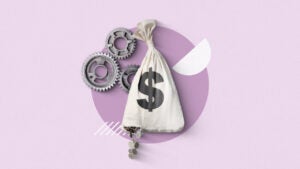What is unsecured debt?




Key takeaways
- Unsecured debt doesn’t require you to offer collateral, such as a vehicle or a home, to secure the loan.
- Because unsecured debt is riskier for lenders, interest rates are typically higher, and approval requirements are more stringent.
- Personal loans, credit cards and student loans are common types of unsecured debt.
- To get rid of unsecured debt, you’ll have to pay it off or consider bankruptcy to discharge your debts.
When you take out a loan or other type of financing, you’ll typically have two options: secured or unsecured debt. The key difference is if or not you need to put up collateral — like your home or vehicle — to protect the lender in case you fail to repay the loan.
Unsecured debt, or any debt that isn’t backed by collateral, is a common option for many borrowers. Lenders usually charge higher interest rates for unsecured versus secured debt since it’s riskier, but when managed responsibly, it can be a useful tool for achieving financial goals without risking assets.
Unsecured debt vs. secured debt
Secured debt creates far less risk for lenders compared to unsecured debt. Since the lender has more leverage if you fail to repay what you owe, secured debt is often associated with lower interest rates and more favorable loan terms. However, your property is at risk if you default on the loan.
Unsecured debt doesn’t require you to put any assets on the line. This offers more flexibility, particularly if you don’t have assets to offer as collateral. However, lenders typically mitigate the risk by requiring higher minimum credit scores and charging higher interest rates.
For example, while they’re similar in loan amounts and repayment terms, home equity loan rates are typically lower than personal loan rates. However, a personal loan won’t risk your home if you are unable to repay what you borrow.
| Unsecured debt | Secured debt | |
|---|---|---|
| Asset attached | No | Yes |
| Interest rate | Typically higher | Typically lower |
| Consequences of defaulting | Lowered credit score, fees, debts sent to collections | Lowered credit score, fees, repossession of asset |
| Given a title after repaying the loan | No | Yes |
Examples of unsecured debt
Credit cards and most personal loans are the most common types of unsecured debt. Although lenders typically charge higher interest rates on these types of debt, there are strategies you can use to lessen the financial burden.
For instance, you may qualify for a credit card introductory rate of 0 percent. Credit cards typically do not charge interest if you pay off your balance each month. Personal loans also often offer lower rates for those with excellent credit and steady income.
Examples of secured debt
Common types of secured debts include auto loans, mortgages, home equity loans and home equity lines of credit (HELOCs).
Since auto loans are backed by your vehicle, the lender can repossess it if you default. When it comes to mortgages, home equity loans and home equity lines of credit, defaulting puts you at risk of foreclosure.
In some cases, you can use other valuable assets like a savings account or jewelry as collateral. This adds flexibility but still carries the risk of repossession if you fail to meet your obligations.
What happens if you don’t pay an unsecured debt?
While a lender can’t immediately take your assets if you fail to pay an unsecured debt, there are still potentially serious consequences depending on the circumstances of the loan.
- Collections: If the debt remains unpaid for too long, it may be sent to a collection agency. Even if you pay off the debt quickly, an account going to collections can stay on your credit reports for seven years.
- Credit score: Your credit score will suffer since payment history accounts for 35 percent of it. This will make it harder for you to get approved for future loans.
- Fees: You’ll likely incur late fees for missed payments, though the amount will depend on your lender’s policies. Some lenders don’t charge late fees but may adjust your interest rate.
- Wage garnishment: Depending on your loan type, your wages might be subject to garnishment if you fail to repay your debt.
- Lawsuits: A creditor might also sue you in court and place a lien against your property. If a court awards a judgment to the lender, your assets may be at risk. State laws vary, so some personal assets may be protected from seizure.
How to get rid of unsecured debt
There are generally two main options for getting out of unsecured debt: pay it off or file for bankruptcy.
Option 1: Pay off the debt
Depending on your income, goals and overall financial situation, there are several potential paths you can take to pay off your debt:
- Rework your budget: If you can reduce your expenses elsewhere, you can shift your finances to pay down the debt faster by dedicating more of your expendable or unassigned income to eliminating the debt.
- Consolidate your debt: You can use a debt consolidation loan to merge your balances into a single loan product, typically with a lower rate. The idea is to save a sizable amount in interest and pay the balance off faster. Be careful not to use the credit cards you consolidate, though, or you could end up with far more debt than you started with.
- Request hardship assistance: Many lenders offer hardship programs. These programs can sometimes help you get temporarily lowered interest rates, payment pauses, reduced minimum payments, waived late fees or due date extensions for a short time. This may help you get caught up again on your payments if you are behind.
Option 2: File for bankruptcy
If paying back the debt is not an option, you may need to consider filing for bankruptcy. There are two common types of bankruptcy for individuals, Chapter 7 and Chapter 13.
- Chapter 7 bankruptcy: You can typically discharge most, if not all, of your unsecured debts. The process typically takes a few months to complete and can provide you with a fresh start, but it sits on your credit report for up to 10 years.
- Chapter 13 bankruptcy: This involves creating a repayment plan to pay back a portion of your debt over a three- to five-year period. Any remaining debts are usually discharged. Chapter 13 doesn’t provide the immediate relief of Chapter 7, it allows you to keep your assets and may have a slightly less severe impact on your credit.
Before deciding on bankruptcy, it’s important to consult with a bankruptcy attorney to fully understand the implications and determine if it’s the best course of action for your situation.
Bottom line
Unsecured debt can be a useful financial tool, offering the financing you need without putting your assets on the line. However, due to the increased risk for lenders, it typically comes with higher interest rates and more stringent qualification requirements.
If you’re managing unsecured debt, it’s important to stay on top of payments and explore strategies to minimize the impact of higher interest rates. Consider setting up a plan to pay off your unsecured debt or consult with a financial advisor to explore your options. Should your financial situation become overwhelming, you may consider debt consolidation or bankruptcy.
Understanding your choices and taking proactive steps can help you manage your debt more effectively and work toward a healthier financial future.
Frequently asked questions
Why we ask for feedback Your feedback helps us improve our content and services. It takes less than a minute to complete.
Your responses are anonymous and will only be used for improving our website.
You may also like

The best unsecured cards for bad credit

$15k personal loans: Everything you need to know

What is an unsecured business loan and how does it work?

